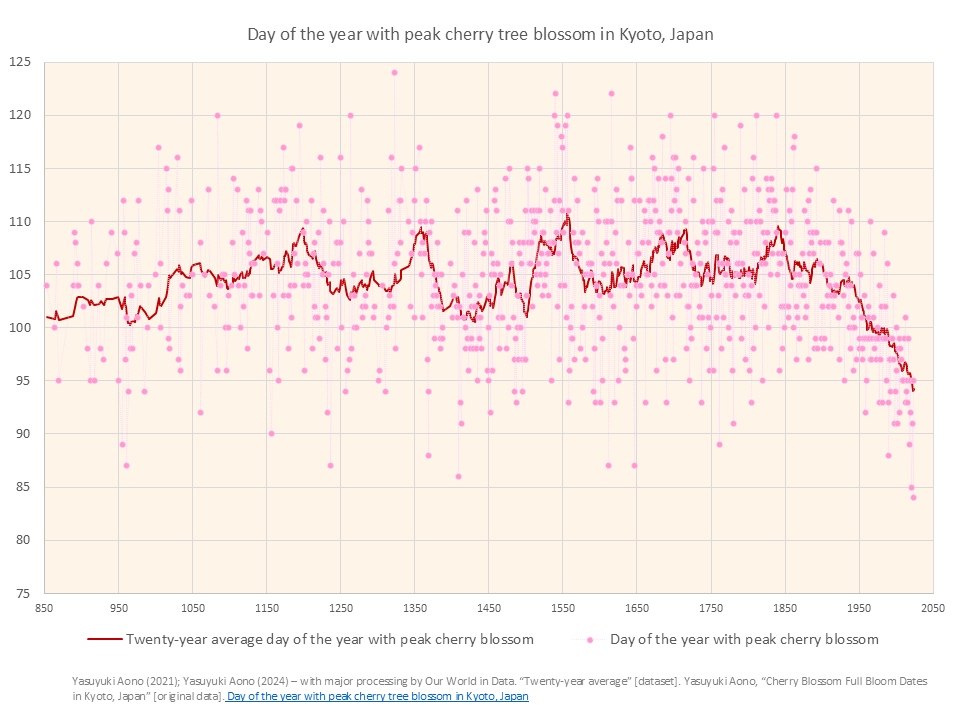Pick Up
1226. Impact of Climate Change on Cherry Blossom Flowering

1226. Impact of Climate Change on Cherry Blossom Flowering
According to the Japan Meteorological Agency, cherry blossoms in Tokyo have bloomed on March 14, 2021, March 20, 2022, March 14, 2023, and March 29, 2024 in the past few years, and in 2025, they bloomed on March 24, five days earlier than last year, which is considered to be average.
The peak of cherry blossom blooming in Kyoto has been recorded in diaries and chronicles since the 9th century as the date of cherry blossom viewing parties and other observation dates of full bloom, and is considered a proxy indicator of long-term climate change. Due to the combined effects of urbanization and rising temperatures due to climate change, the peak blooming has gradually come earlier since the early 20th century.
Long-term records of flowering seasons observed at the distribution limits of species are useful for understanding the impact of climate change on flowering seasons and developing flowering prediction models. Especially in temperate regions, the timing of flowering is said to be determined by the balance between cold exposure (low temperature requirement) for releasing dormancy and heat requirement for flower bud growth. On the other hand, if abnormally warm winters like last year or weather conditions with large daily temperature fluctuations like this year become the norm, it may become more difficult to predict cherry blossom flowering (https://www.jircas.go.jp/ja/program/proc/blog/20240401).
In order to clarify the impact of climate change on cherry blossom flowering phenology, a study was conducted on Hachijojima from 1948 to 2024 to examine the relationship between cold exposure (low temperature requirement) required to release dormancy and heat requirement required for bud growth, and found a significant relationship between cold exposure and heat requirement, approximated by a linear or log-linear function. In years with low cold exposure, the start of flowering was significantly delayed compared to normal years in response to higher heat requirement.
In the 2023-24 warm winter in Japan (1.0-1.6°C higher than the 1991-2020 climate normal), the first flowering date (April 15) of Somei-Yoshino cherry trees (Cerasus × yedoensis) on Hachijojima, located at the southern limit of the full-bloom range, was surprisingly the same as that of Aomori, located about 860 km north-northeast of Hachijojima. This equivalence may be due to the difference in the balance between cold exposure and heat requirement between the two climates.
Furthermore, a flowering phenology model under future warming indicates that Somei-Yoshino may no longer flower at its southern distribution limit due to insufficient cold exposure. These results indicate that the transition period from endodormancy release to bud growth and the heat requirement are likely to depend on the degree of exposure to cold, and therefore warming may delay or prevent the flowering date of Somei-Yoshino cherry trees at their southern distribution limit.
The results suggest that the variation in the balance between cold exposure and heat requirement in response to annual temperature change patterns is likely to significantly alter the flowering start date in the distribution range of Somei-Yoshino cherry trees.
(Reference)
Shin, N., Saitoh, T.M., Takasu, H. et al. Influence of climate change on flowering phenology of Yoshino cherry at its southern distribution limit. Int J Biometeorol 69, 275–279 (2025). https://doi.org/10.1007/s00484-024-02797-0
Contributor: Miyuki IIYAMA, Information Program
